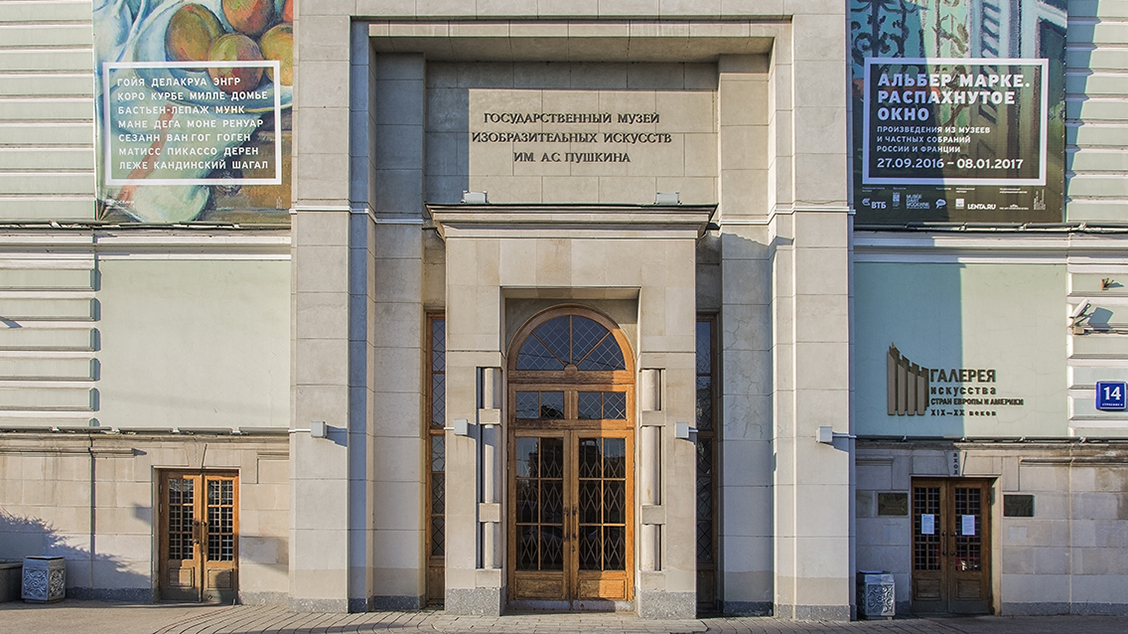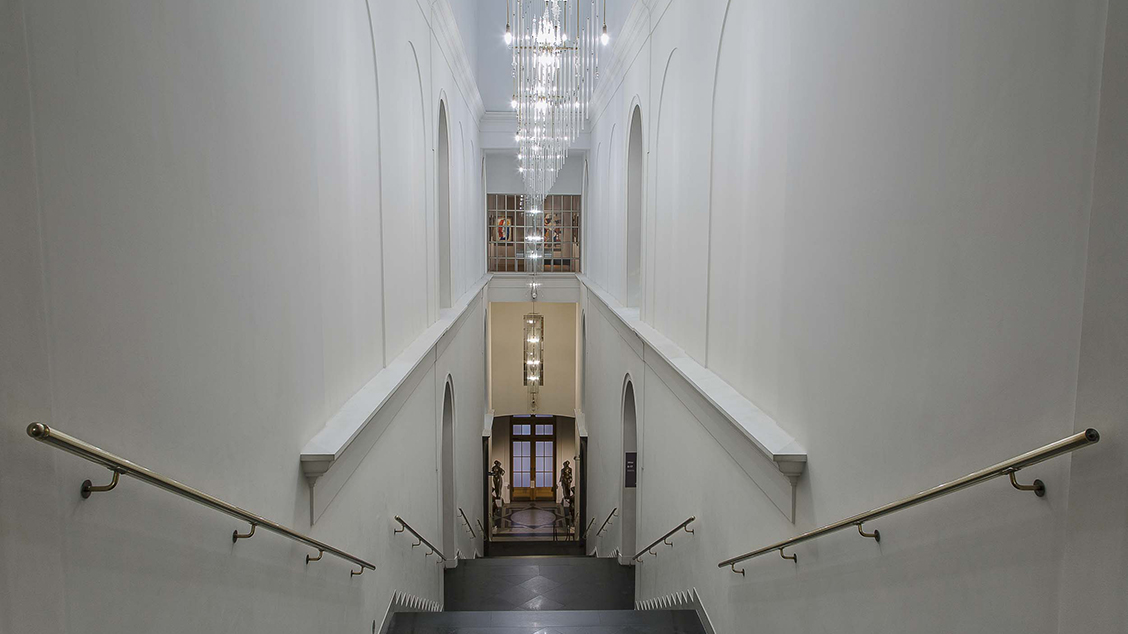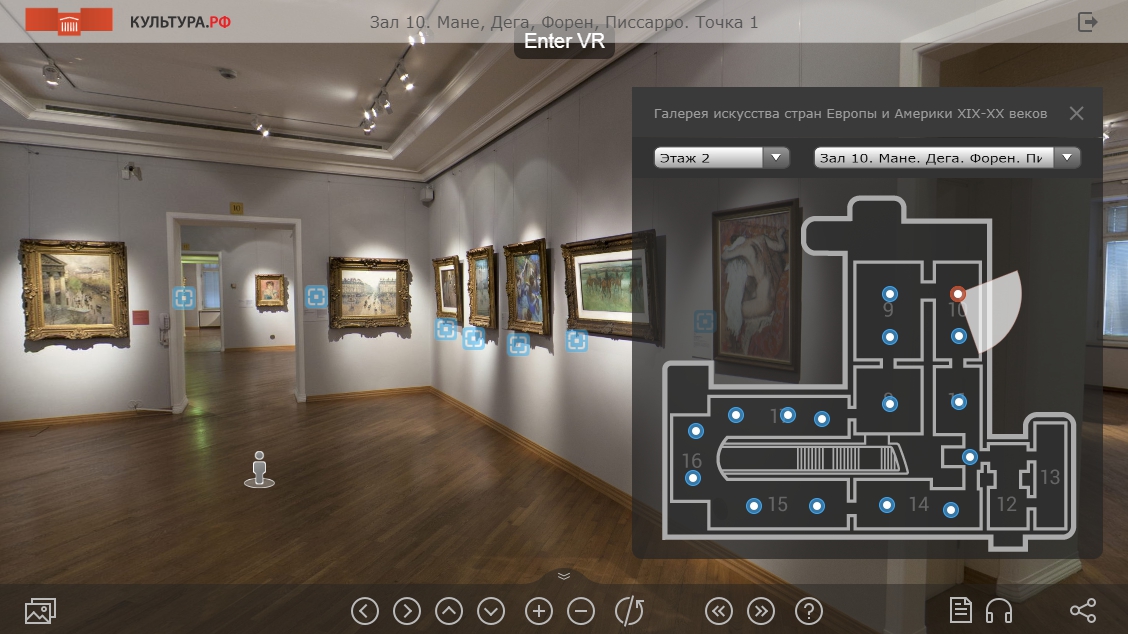The Gallery of Art from the Countries of Western Europe and America of the 19th and 20th centuries opened its doors to the public in August 2006.
Twenty-six of the Museum's galleries contain a wide-ranging collection of works by masters of the 19th and 20th centuries. There are whole galleries devoted to individual trends in European art or to the work of a single artist. In a gallery specially set aside for the purpose there are works by the German school of the early-19th century, represented by Caspar David Friedrich and the "Nazarene" painters. Small galleries enable the public to appreciate, in a new light, well-known works by Eugène Delacroix and Ingres. The Spanish school is represented by Goya. A separate gallery has been set aside for members of the Paris salon dedicated to the work of J. Jerome, P. Delaroche and E.L.Izabe Works by French landscape painters Corot and the artists of the Barbizon school - Théodore Rousseau, Jules Dupré, Diaz de la Pena and Charles-François Daubigny seem almost predestined for the interiors of this Museum. Canvases by Gustave Courbet, Jean Millet and Honoré Daumier further enhance this panorama of French realist art.
Pride of place in this gallery is assigned to the painting of French impressionists, post-impressionists and masters from the early-20th century: Claude Monet, Auguste Renoir, Alfred Sisley, Camille Pissarro, Edgar Degas, Paul Cézanne, Paul Gauguin, Vincent van Gogh, Henri de Toulouse-Lautrec, members of the "Nabis" group, Henri Matisse, Pablo Picasso, André Derain and Henri Rousseau.. In a new display it is possible to find works by representatives of other European schools as well and also works of American painters. Alongside canvases by Kandinsky, Chagall and Georgio de Chirico hang pictures by Achille Funi, Karl Hofer, Felice Casorati, H. Grundig, F. Beringer and Rockwell Kent. Works by major European sculptors are also on display – Barye, Rodin, Maillol, Bourdelle, Ossip Zadkine and Hans Arp.
The building at 14, Volkhonka St. was previously the left wing of the residence of the Princes Golitsyn in the 17th-19th centuries, which had been built by the St. Petersburg architect, S.I.Chevakinskii, and the Moscow architect, I.P.Zherebtsov. This building was later lent features in the style of Early Classicism by the celebrated architect M.F.Kazakov.
In 1890-1892 it was redesigned to provide rented accommodation and came to be known as "Princes Court". Great Russian artists Vasilii Surikov, Ilya Repin and Leonid Pasternak lived there for many years, as did the composer Alexander Scriabin.
When this building was acquired by the Pushkin Museum, it was completely renovated between 1988 and 1993 in order to house the Department known as the Museum of Private Collections. This carried forward the traditions of the original building, where a picture gallery and Classical "rarities" from the collection of M.A.Golitsyn had been on display for the public.
In this sense the Gallery of Art from the countries of Western Europe and America of the 19th and 20th centuries takes up the torch, since the history of the assembly of its collection is inextricably linked with the history of art collecting in Moscow and the names of such famous patrons of the arts as Sergei Tretyakov, Sergei Shchukin and Ivan Morozov.
The display in the rooms of the Gallery of 19th and 20th century European and American Art brings together works which once formed part of famous collections connected with the history of our country. These collections first began to be assembled in the middle of the nineteenth century. At that time a new phenomenon appeared in Russia's second capital, commerce-loving, dynamic Moscow: a group of factory-owners, rich merchants and industrialists had the idea of building up collections of contemporary art, which would be accessible to the public and promote the worthy cause of public edification. In Moscow the gallery of Pavel Mikhailovich Tretyakov was opened and soon became famous.
Tretyakov built up a systematic collection of works by contemporary Russian painters and later donated his collection to his native town. His younger brother, Sergei, was also a major collector, who specialised in West European painting of the middle and second half of the nineteenth century. His business involved long trips abroad, to Paris in particular, which gave him an excellent opportunity to visit exhibitions, meet artists and dealers, and acquire pictures. He was perceptive enough to recognise the artistic significance of the Barbizon school. Sergei Tretyakov's Moscow mansion in Prechistensky Boulevard was adorned with paintings by his favourite artists Charles Daubigny and Constant Troyon, and also works by Jean-Francois Millet, Virgile Narcisse Diaz de la Pena and Jules Dupre. The collector was particularly interested in Camille Corot. He drew attention to the paintings of Eugene Delacroix and other masters of the Romantic trend, and also Realist works, which became very popular with the Russian public, first and foremost, the paintings of Jules Bastien-Lepage.
Other members of merchant families also collected pictures by Western artists and even commissioned them specially, such as the sugar magnate Pavel Ivanovich Kharitonenko. However, a new page in the history of Russian collecting was opened up at the end of the century when contemporary art works by painters who subsequently became world-famous appeared in Moscow. At a time when the debate was still continuing in France about whether or not to recognise the painting of the Impressionists and Post-Impressionists, Moscow businessmen were beginning to purchase pictures by contemporary masters in Paris galleries. One of the first was Mikhail Abramovich Morozov, who took what was the extremely bold step for that time of acquiring Edouard Manet's sketch Tavern (1879). At the same time as Morozov, the textile magnate Sergei Ivanovich Shchukin conceived the idea of forming a collection of contemporary art. An energetic and enterprising man, Shchukin was obsessed with the new French art. From the very beginning he possessed an unerring collector's intuition and good eye. Most of the works he acquired are masterpieces. With each new passion Shchukin's house in Bolshoi Znamensky Pereulok acquired more first-class works turning into a virtual museum.
Thanks to his love of Impressionist painting the "Monet room" appeared where you could trace the evolution of the master's work. This passion for the Impressionists was replaced by a period of systematically collecting Paul Gauguin's painting. In the late 1900s and early 1910s Shchukin became a serious commissioner and patron of two eminent twentieth-century artists - Henri Matisse and Pablo Picasso. In the 1910s the mansion in Bolshoy Znamensky became a place of pilgrimage for lovers of contemporary art and Russian avant-garde artists to whose training the Shchukin gallery contributed in no small way. Concerned about the fate of his unique collection, Shchukin decided even before the revolution to donate it to the city of Moscow.
Another owner of textile mills and member of a well-known family, Ivan Abramovich Morozov, began collecting contemporary art with his Paris purchases in 1903 and gradually adorned his mansion in Prechistenka with objets d'art turning it into a real museum, after building up a whole collection of works by contemporary artists. Ivan Morozov gave preference to early intimate Impressionist landscapes and canvases by Paul Cezanne. Pride of place in his collection belonged to works of the Nabis group; the main hall in the mansion was adorned with decorative panels by Maurice Denis and the main staircase with paintings by Pierre Bonnard. Morozov's approach to collecting was basically an art-historical one. He frequently followed the advice of Russian critics and artists. The painter Valentin Serov often accompanied him to Paris galleries and studios.
Moscow's fame as a centre of collecting contemporary Western art was also reinforced by other private collections. An important role in this was played by the works in the collections of I.S. Ostroukhov, Z.V. Ratkova-Rozhnova, S.A. Polyakov and S.V. Shcherbatov. After 1917 all these private collections were nationalised and specialists were appointed to systematise, describe and publish them. Yakov Alexandrovich Tugendhold, the talented critic and art historian, who was an authority on contemporary art and close friend of Shchukin, worked in Shchukin's house which became the First Museum of Modern Western Painting. The Morozov collection, the Second Museum of Modern Western Painting, was supervised by Boris Nikolaevich Ternovets, thanks to whose initiative a very scholarly study of the collections was begun. He worked most actively after the merging of the two collections under the roof of the Morozov mansion. It was here that the world's first and largest State Museum of Modern Western Art was opened, which also acted as a research centre. Ternovets not only popularised the collection, but also sought to enrich it with high quality new works. In the 1920s and 1930s he managed to organise some exhibitions and inter-museum exchanges, as a result of which the new Museum displayed pictures by French, Italian, German, Belgian, Czech and Polish masters.
This fruitful work was cut short by World War II and later the Stalinist campaign against formalism, to which the Museum fell victim. In 1948 it was closed and the collection was divided up between the Pushkin State Museum of Fine Arts in Moscow and the State Hermitage in Leningrad. This new chapter in the history of the collection was heralded by some important events. As successor to the State Museum of Modern Western Art the Pushkin Museum continued to develop its foreign contacts, receiving visits and donations from Fernand Leger's widow, Nadya Leger, and Henri Matisse's secretary, Lydia Delectorskaya. Many works were acquired from exhibitions. In the late 1990s the collection was enriched with pictures by Vasily Kandinsky and Marc Chagall, donated by the artists' relatives.
Over the decades the Pushkin Museum's specialists have continued to study the collection, publish new investigations, material and catalogues, and organise exhibitions in Russia and abroad. This work of many years has led to the setting up of the Gallery of 19th and 20th century European and American Art of the Pushkin State Museum of Fine Arts.





